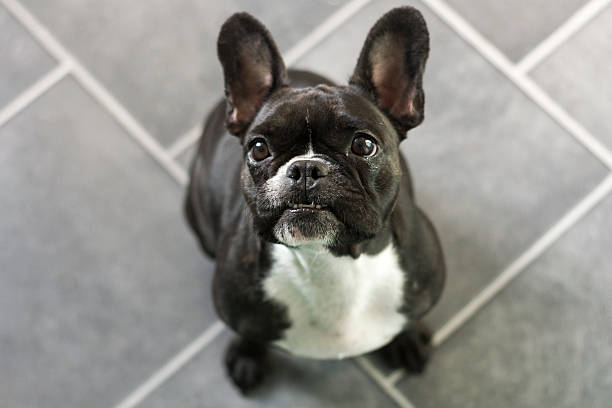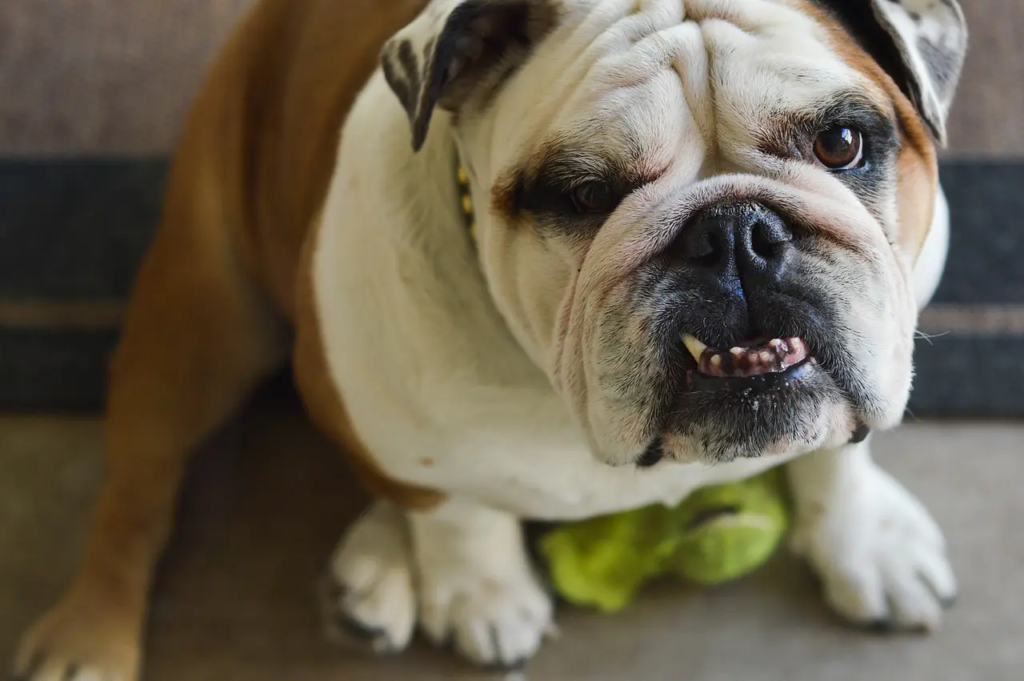Underbite Dogs

A French Bulldog (colour brindle with white) sitting on a tiled floor and facing the camera. Expecting treats or food.
Underbite Dogs:- An underbite is a specific type of malocclusion, which means “bad bite.” In an underbite, the lower jaw protrudes too far forward, causing the bottom and top teeth to misalign when the mouth is closed. This can result in a noticeable snaggletoothed appearance in dogs, where one or both lower canine teeth may stick out prominently. An underbite is also known as Type 3 Malocclusion in dogs. However, dogs can experience other malocclusions as well, including overbites (Type 2 Malocclusion) and cross-bites, similar to what people can experience.
Signs of an Underbite in Dogs
An underbite in dogs can present with several noticeable signs and symptoms. Here’s what to look for:
– Prominent Lower Jaw: The most apparent sign is a pronounced lower jaw, sometimes described as a “salmon jaw” or “dog-like face.”
– Mouth Issues: The dog may struggle to close its mouth fully or may have a slightly open mouth that resembles a fish.
– Food Spills: Food frequently falls out of the dog’s mouth while chewing.
– Misaligned Teeth: When the mouth is at rest, some teeth may remain exposed or misaligned.
– Teeth Irregularities: You might notice a mix of puppy and adult teeth or adult teeth that haven’t grown in properly.
If left untreated, an underbite can lead to more than just an uneven smile—it can also cause significant discomfort and pain for your furry friend.

Dental Damage: Impaired teeth can harm the gums and soft tissues in the mouth.
Difficulty Eating: Problems with swallowing or chewing can arise.
Gum and Oral Disorders: Issues may affect the gums, palate, cheeks, and other teeth.
Tartar Build-Up: Excessive tartar and calculus can accumulate.
Wear and Periodontal Disease: Increased risk of tooth wear and periodontal diseases.
Digestive Problems: Difficulty in digesting food can occur.
Ongoing Discomfort: This may lead to continuous discomfort compared to “normal biting” dogs.
Oronasal Fistula: This condition involves an abnormal connection between the mouth and nose.
Caring for Dogs with Dental Issues: Early care and treatment can help manage symptoms, and prevent pain, eating difficulties, and other related problems.
Is an Underbite Healthy for My Dog?
Identifying an underbite in dogs can be trickier than in humans due to differences in jaw structure. You can usually spot an underbite when your dog is relaxed and their bottom teeth protrude slightly from under their lips.
If your dog can chew solid foods without difficulty, move their jaw comfortably, and bite properly, an underbite is typically not a cause for concern. This trait is quite common in breeds with short muzzles and flat faces.
Which Breeds Are Prone to Underbites?
Underbites are often found in brachycephalic breeds—those with short, “pushed-in” faces. These breeds have a genetic tendency toward underbites because of their skull and jaw structure. Some dog breeds particularly known for this trait include:
– Boxer
– Bulldog (English and French)
– Pug
– Boston Terrier
– Pekingese
– Shih Tzu
– Lhasa Apso
– Cavalier King Charles Spaniel
– Brussels Griffon

Though these breeds are more commonly associated with underbites, any dog, regardless of breed, can develop this condition. Underbites may also occur in other breeds, albeit less frequently, due to genetic factors, developmental issues, or jaw injuries.
Complications of Underbites in Pets
Malocclusions, such as underbites, can be noticeable in pets as early as eight weeks of age. While some young pets may outgrow these misalignments, others may face complications as their adult teeth come in around 6-8 months of age.
Misaligned teeth can cause discomfort by digging into surrounding gum tissue or rubbing against other teeth, making eating painful. In severe cases, a misaligned canine tooth may create an oronasal fistula, a rare condition where an abnormal opening forms between the mouth and nasal cavity.
An improper bite alignment can hinder your pet’s ability to close their mouth fully, potentially impacting their breathing. Additionally, with lower teeth and gums frequently exposed, there is an increased risk of drying out and developing bacteria that can lead to gingivitis, as saliva plays a crucial role in bacteria removal.
Over time, malocclusions can also affect your pet’s posture and increase their susceptibility to hip and joint issues as they age.

What Causes Canine Malocclusion?
Canine malocclusion can arise from various factors, categorized into dental and skeletal abnormalities. Dental malocclusions involve teeth that are misaligned due to their positioning, while skeletal malocclusions result from irregularities in facial structure that affect how teeth align.
1. Hereditary Factors: Certain dog breeds are prone to malocclusion due to their facial structure. Breeds with short or long faces, often resulting from selective breeding, can exhibit these issues.
2. Developmental Issues: Malocclusions can also stem from infections during gestation or development, affecting the normal alignment of teeth. Additionally, retained milk teeth that fail to fall out can cause overcrowding and misalignment.
3. Trauma: Physical injuries, such as bites from other animals or accidents like being hit by a car, can lead to malocclusion by causing fractures or shifts in the jaw.
Canine Braces May Be Necessary for Severe Underbite
If your dog has a severe underbite, finding a solution may not be straightforward. For adult dogs, treatment often involves simple procedures like teeth extractions or filing down specific teeth. However, since a puppy’s jaw is still growing, there are more options to consider. One potential treatment for puppies is the use of braces.
Just as braces can realign teeth in children, they can also be used in animals. Veterinary dentists have been applying braces since the 1980s, though in veterinary practice, they are used strictly for medical reasons, not cosmetic ones.
If your veterinarian suggests braces for your dog, they will first assess whether your pet is healthy enough for the procedure. Braces require general anesthesia for taking radiographs (x-rays) and placing the braces. Additional anesthetic sessions might be needed for adjustments or removal. In between these sessions, your dog will need to be rechecked, which involves examining their mouth without sedation. Naturally, a well-behaved pet can make this process easier, so behavior is an important factor in deciding if braces are the right option.
Also Read:-




